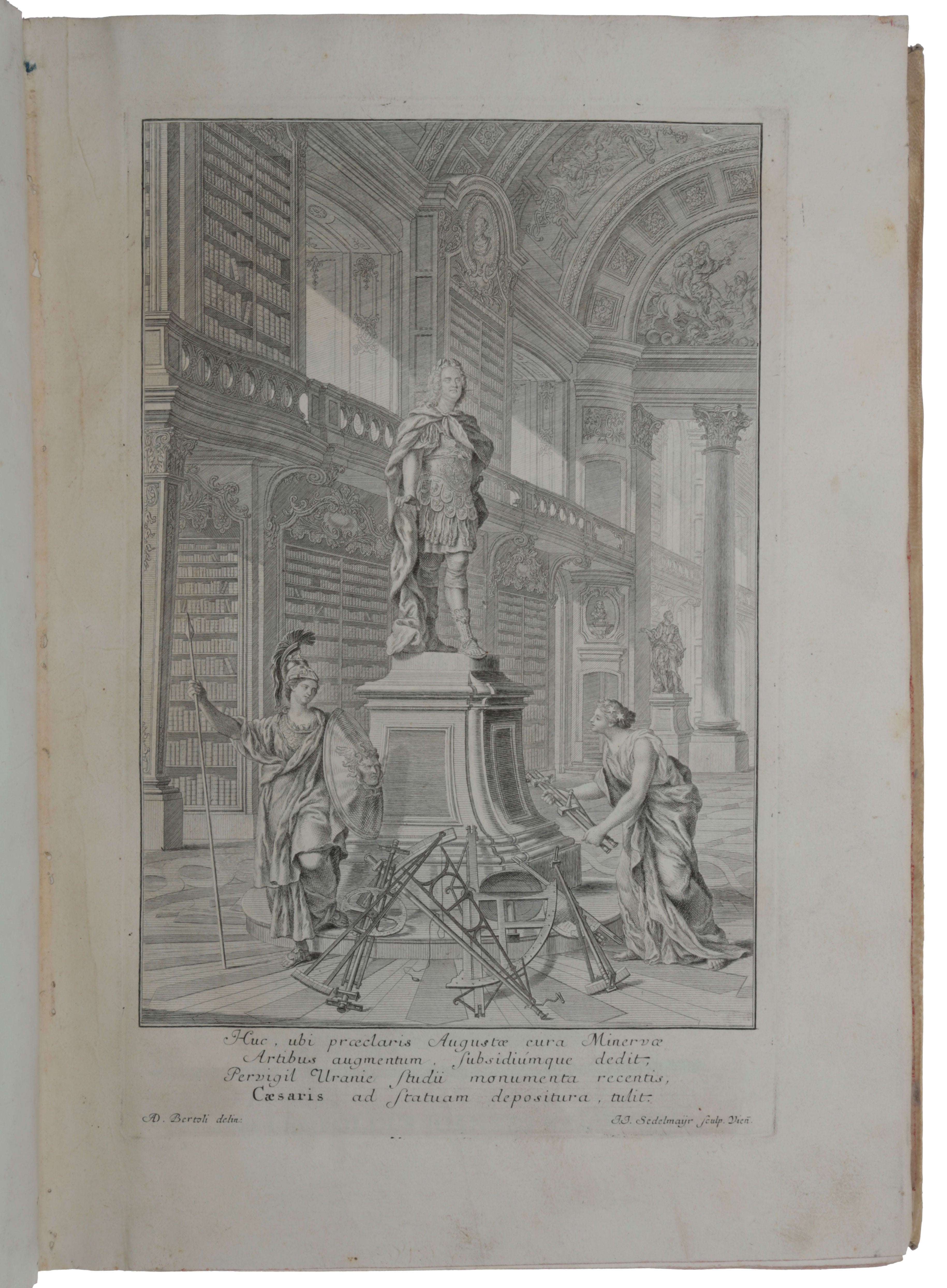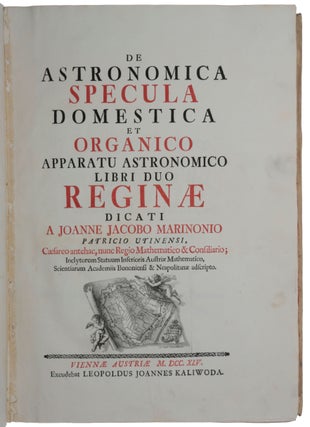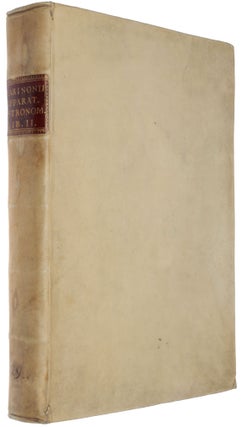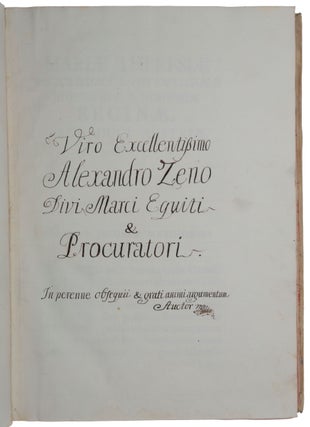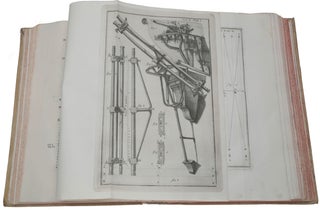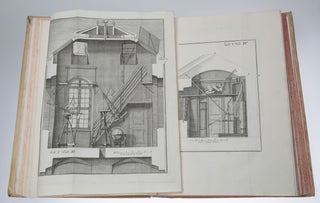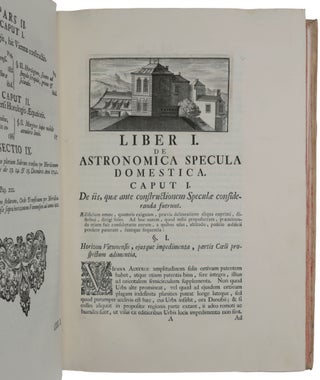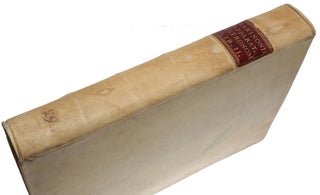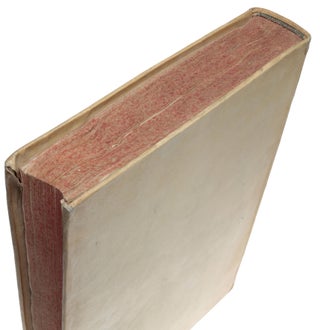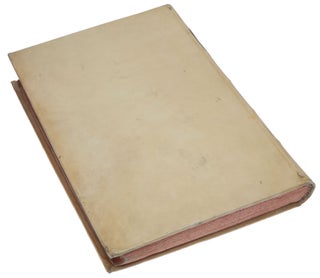De Astronomica Specula Domestica et Organico Apparatu Astronomico.
Vienna: Leopold J. Kaliwoda, 1745. First edition, author’s presentation copy, of “one of the most exquisitely illustrated astronomical works ever printed” (Kenney, p. 200), which describes and illustrates the astronomical instruments in the private observatory of Marinoni, mathematician and astronomer to the Imperial Court of Austria and geodetic surveyor. Like the private observatories of Tycho Brahe and Hevelius in the two preceding centuries, Marinoni’s observatory was one of the most beautiful and best equipped in Europe in his time. He built his own instruments and those illustrated here include quadrants, telescopes, micrometers, an improved Graham pendulum, and a camera obscura. Marinoni left all the instruments to the Empress Maria Theresa, to whom he dedicated this work. Some of Marinoni’s astronomical observations appeared in journal articles, but many remain unpublished in manuscript. “In January 1755, the Viennese court mathematician Johann Jakob (Giovanni Jacopo) Marinoni (1676-1755) passed away. Originally from Udine, Marinoni … was appointed in 1703, and from 1720 he also served as the second director of the Viennese Imperial and Royal Academy for Engineering (Wiener kaiserliche und königliche Ingenieurakademie), established in 1717 under the auspices of the Aulic War Council primarily to ensure the adequate training of military engineers. During his more than five-decade career in Vienna, Marinoni also played leading roles in large-scale government-run projects, from modernizing and expanding the system of fortifications around the capital to the land survey of Lombardy (the so-called ‘Theresan cadaster’—in fact begun long before Maria Theresa’s accession). As a surveyor, he introduced new methods and instruments in the Habsburg lands; as an astronomer, he carried out observations (also popularized in broadsheets) and even assembled students to instruct in the small observatory in his home in central Vienna, equipped with instruments purchased from far and wide, and donated in his last will to the court. In 1745, Marinoni published a volume describing the observatory, its activities, and equipment in great detail. The book was dedicated to the empress, and recommended by its reviewers, Frölich and Franz, as a textbook” (Aspaas & Kontler, p. 91). No presentation copy listed on ABPC/RBH. Provenance: Author’s presentation copy to Alexandro Zeno (presentation inscription on inserted leaf). Contemporary corrections on pp. 16, 45, 46, 49, 57, 72, 73, 74, 80, 81, 85, with notes on pp. 44, 64, 71, 95, 101. A pupil of the Barnabites in Udine, where he studied Euclidean geometry, Marinoni obtained a degree in philosophy in Vienna in 1698. There he became the protégé of Leandro Anguissola, teacher at the Academy of the Nobles. In 1702 Marinoni became professor at the prestigious Academy of Estates in Lower Austria. His teaching was so successful that, in the following year, he was appointed by Emperor Leopold as imperial court mathematician and teacher of the later Empress Maria Theresa. Marinoni’s first works were in the fields of cartography: the planning and mapping work on the Linienwall (1704) and the Anguissola-Marinoni plan of Vienna (1706) were the first fruits of his efforts in this field. As a representative of the Crown Land of Austria under the Enns, he surveyed national borders, produced border maps and mediated in border disputes. Skilfully produced maps of manorial estates earned him many recommendations from the Austrian nobility. The imperial approval of the engineering academy in 1717 and his appointment as deputy director under Anguissola established his professional position. The first polytechnic training institute for officers and civilians in Central Europe was based in Marinoni’s house on the Mölkerbastei in Vienna. At the request of the Austrian governor of the state of Milan, the court war council, to which the engineering academy was subordinate, sent Marinoni to Lombardy in 1719. There he demonstrated a high level of expertise, great organizational skill, and made a significant contribution to the creation of the Milan cadastre, the first land register of an entire country on a cartographic basis. To carry this out Marinoni used a ‘planimetric libra’, a tool for computing areas of surfaces that he had invented in 1713-14. Marinoni corresponded with a number of prominent scientists at this time, including Leibniz. Marinoni described this work in his posthumous De re ichnometrica veteri ac nova (Vienna, 1775). Marinoni was obliged to continue his surveying work in Italy until 1723, as he had to carry out hydrometric measurements and the surveying of fortifications and borders. After Anguissola’s death in 1720, Marinoni was initially denied the directorship of the engineering academy, despite direct intervention by the President of the Court War Council, Prince Eugene of Savoy, whose personal protection he enjoyed. His actions within the academy were not always to the satisfaction of his military superiors: the admission of foreigners was criticized, as was the lack of focus on practical military needs. After his elevation to the imperial nobility in 1726 and his appointment to the Imperial Council in 1733, at almost 50 years of age, he was finally appointed head of the academy. Throughout this period, Marinoni lived alone and devoted his free time to mathematics and astronomy. In 1730 the first astronomical observatory in Vienna, designed and set up by Marinoni in his own home, was inaugurated. He had already discussed this with Leibniz in 1714 during the philosopher’s stay in Vienna and later kept him informed of the troubled plans for implementation. In fact, the observatory, irregularly financed by the sovereign’s private coffers only for a few years, operated from 1740 until Marinoni’s death under his total responsibility, without permanent employees. Nevertheless, Marinoni made regular astronomical observations, which were disseminated by letter or in manuscripts. Marinoni bought instruments in Pavia, Venice, and London, by the Milanese optician P. Patroni, by the Venetian D. Selucci and by the Londoner E. Scarlet. After a ten-year gestation, Marinoni celebrated his professional and scientific success by publishing De astronomica specula domestica etorgan apparatu astronomico. This work represents the synthesis of Marinoni’s life. Six years later, he published his treatise on surveying, De re ichnographica cuius hodierna praxis exponitur et propriis ex pluribus illustrator. In Marinoni’s view, the skills of the cartographer and the astronomer are complementary: the sovereign’s interest is no longer just the city, but the territory, and even the universe as a whole; consequently, it is the court employee’s responsibility to apply his technical expertise to describe and measure both the land and the sky. Marinoni was honoured with memberships of of scientific societies all over Europe, including Bologna, Olmutz, St. Petersburg, Berlin, and the Royal Society of London. He conducted extensive professional and private correspondence with great scientists of his time, such as Zanotti, Delisle, Poleni, Maraldi, Cassini, Rinaldi, Bertoli, Florio, Bini, and Euler. A second edition of De Astronomica Specula was published in 1746. Kenny, Catalogue of Rare Astronomical Books, p. 200 (1745 edition); Lalande 426; Poggendorff II, 53; Riccardi II, 119; cf. Zinner, Astronomischen Instrumente, 206 & 437 (1746 edition).
Folio (350 x 244mm), pp. [xxiv], 210, [2], with 43 folding engraved plates, engraved frontispiece signed Sedlmayr after Bertoli, title printed in red and black with engraved vignette of two putti unfolding a plan of Vienna, engraved and woodcut initials, head- and tail-pieces, 10 full-page illustrations on 5 leaves, 7 further illustrations in text, final leaf with errata and instructions to binder in Latin and German (some wormholes in margin of title, text unaffected). Contemporary Italian vellum, spine with gilt title on red morocco label, manuscript ‘29’ written at bottom of spine, red speckled edges. A very fine copy, extraordinarily crisp and clean.
Item #5400
Price: $38,000.00

